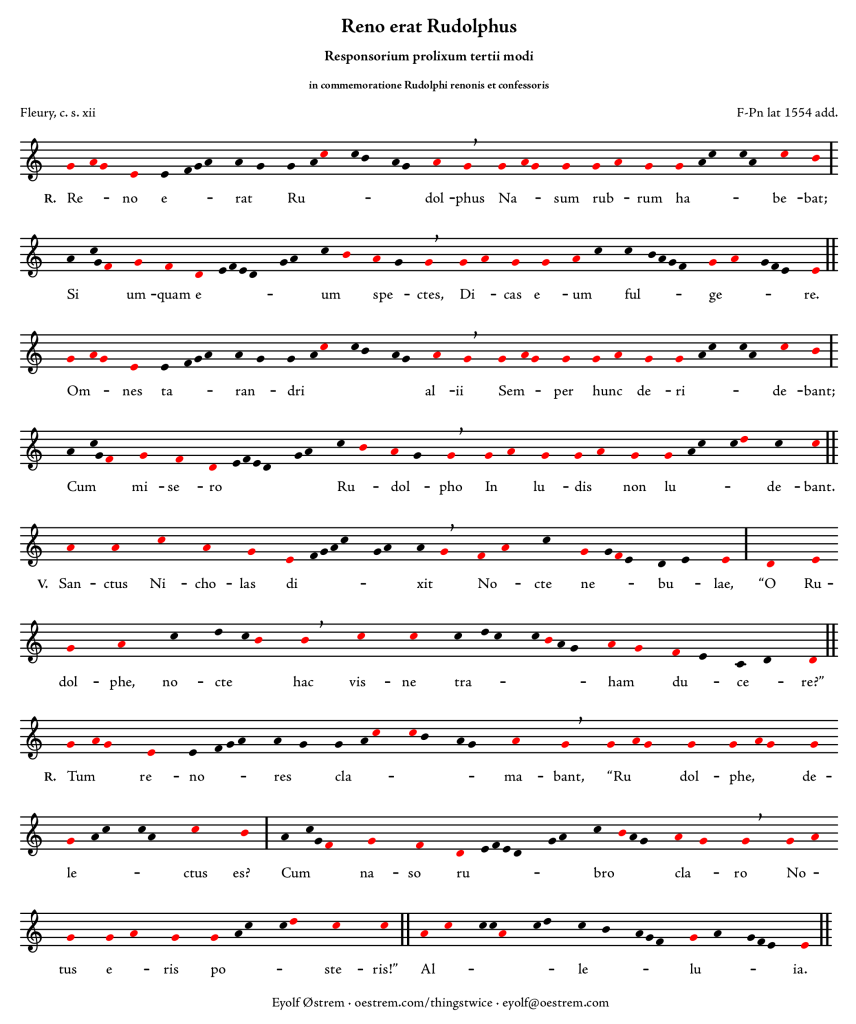First a little background:
Some days ago, my friend Kevin Edelvang, organ grinder at St Stephen’s Church in Copenhagen, sent me a funny little text that started with “Reno erat Rudolphus”. I thought it might be fun to find a Gregorian hymn melody that would fit the metre, and slip the song in at some church occasion during Christmas season.
I browsed around a little but I couldn’t find anything that I was satisfied with, so I decided to write my own melody instead.
I then typeset the melody nicely to make it look like a page from a Gregorian chant book (using the excellent Gregorio software), then sang it a couple of times in a multitrack recording with lots of cathedral reverb, and sent the files to Kevin. He then passed them on to some church musician friends, who passed them on again, and the whole thing exploded.
I put the “manuscript” page up here at the blog, the sound file on soundcloud and eventually a video version on youtube, and in four days there were 50,000+ hits. Quite good for a couple of hours fooling around a Sunday evening.
The melody that came out of this little exercise, is actually quite interesting, if I may say so myself.
- The Phrygian mode. Of course it is a Phrygian melody! Although the modern Rudolph melody is blatantly chordally conceived, the third mode skeleton e-g-a-c’ with the frequent turns to the neighbours of the outer notes (e-d and e-f, and c’d’/cb) actually accomodates for all those tones and melodic outlines that would never have occurred in plainchant.
- Most problematic in this respect is the sequence-like relationship between the first two phrases (“Reno…” and “Si quando…”), and the very un-gregorian tritone leap between b and f between those phrases. Luckily, this could be masked by using standard melodic formulas.
- These are actually the only places where I had to actively mask the melody; for the rest, it was enough to fill in leaps add cadential formulas here and there.
- I made one mistake, which was completely unnecessary: the second phrase (“Si quando…”) should have ended on the low e and not, like the fourth phrase, on c’. This was in fact the one aspect of the chant tune that annoyed me: the repetitiveness of the phrase endings. Ironically, this would have been avoided completely had I just used the correct melody. The corrected version will appear soon in an internet near you.
- I wanted to strike a balance between letting the melody be heard clearly and giving it a convincingly Gregorian melodic style. When even renowned chant scholars were fooled – and when I myself while recording it would forget which melody I was “really” singing – I take that as evidence that it works well as a Gregorian tune.
- That said – apart from a few ornaments, just about every tone in the melody comes directly from the original, as can be seen from this version (with the second phrase corrected and some more textual emendations), in modern notation and with the melody notes marked in red:

Lastly, a few words about the text. The “textus receptus” that Kevin initially sent me has been floating around on the internet without attribution for a long time. But in a comment to the song, I was told that the translation was made by Claes Tande, catholic priest in Norway. I contacted him, but although he did remember having had something to do with the text, he would not claim authorship. Rather, it had something to do with a student expedition back in the eighties from Rome to Istanbul in a Norwegian owned Peugeot 404 1968 model Sherman Tank, where the writing possibly involved some priest candidates from Louisiana and Texas, and where Tande did some language checking.
